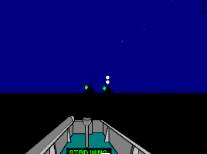Welcome to the website where you can pass online the Seafarer Evaluation Training System (SETS) test on «Keep Navigation Watch, Routing ». Practice like this will help you as a marine specialist improve your knowledge with the help of online studying and appraisal practice. SETS based on practical information and marine specialists experience.
SETS tests developed for evaluating seaman basic knowledge by company “Naval Education Services ” is an evaluating online-tool, used for revealing any professional preparation needed in specific fields of knowledge, defined by STCW Section A-V/1-2.
SETS tests have proven themselves as good tools for the selection and recruitment process, as well as advancing the level of knowledge of the current officers and crew.
Current test contains SETS questions in area «Keep Navigation Watch, Routing ». Those questions can be used for competence verification specialist capable of preventing accidental situations related with transporting safety, or also for self-examination.
«Keep Navigation Watch, Routing » subject includes theoretical and practical information about advanced training for work on any type of vessel. This subject provides comprehensive training for officers responsible for safe vessel navigation during watchkeeping duties. This course covers fundamental principles of bridge watchkeeping as required by STCW (Standards of Training, Certification and Watchkeeping) regulations. Participants learn proper procedures for maintaining navigational watches in various conditions, including restricted visibility and heavy traffic areas. The curriculum includes voyage planning techniques, route selection criteria and consideration of environmental factors. Special attention is given to collision avoidance regulations (COLREGs ECDIS AIS for continuous monitoring. Practical scenarios cover emergency situations, abnormal conditions and proper communication protocols during watch. Mastery of this subject ensures compliance with international maritime safety standards and efficient ship operation.
On this site SETS on the subject «Keep Navigation Watch, Routing » contains 37 questions you need to answer with no possibility to go back to previous question. Therefore, we recommend carefully reading each question and making decision with no hurry. In case you have some difficulty answering, you have also possibility to request a hint.
Use the search below to find question.
Amount of questions: 37 .
Right answers marked with this sign
When using a buoy as an aid to navigation, which of the following should always be considered?
Will snow fall reduce the ability of the radar to detect targets?
S » band radars.
The OOW has, during the pre-departure check of the bridge equipment, found an error in the weather facsimile. What should he do?
At the commencement of a sea voyage the Master, a Pilot, the OOW and 2 ratings are present on the bridge. Who is in charge?
OOW to be in charge.
Who is responsible for the safety of the vessel when the pilot is on board?
OOW .
You need to anchor a ship in 35 meters of open water. How much chain should you use?
shackles .
shackles .
shackles .
shackles .
What is the best way to monitor the risk of collision in poor visibility?
When watchkeepers are inadequately rested, it calls for changes to routine watchkeeping periods. Who is responsible for making such changes?
Which of the following should not be used for collision avoidance?
VHF Radio.
The captain of a vessel has 2 years of experience as a captain and the pilot who is on board has 20 years of experience. Who is in charge?
Two ships approach each other on reciprocal courses, one with a speed of 22 knots , the other with 15 knots . What is their relative speed?
When may positions marked on the navigation chart be erased?
When told to rig a pilot ladder, which side will be commonly chosen?
What is a safe interval between position fixes?
If the OOW is in doubt as to the Pilot’s actions or intentions, what must he do?
When out of sight of land, OOW notices the red rocket. What action he must take?
Who has the responsibility for the watch during a sea passage if the master comes on to the bridge?
OOW that he is taking over.
OOW will share the responsibility whenever the master is on the bridge.
What chart should be used when navigating?
Apart from ensuring navigational safety at anchorage, what should the OOW do?
VHF for orders for the vessel.
Which of following items should be checked before a ship sails?
Which of these factors must be taken into account when deciding the composition of a navigational watch?
When at anchor, what should the OOW do if the vessel appears to be dragging her anchor?
What is the fog signal of this vessel?
minutes .
seconds followed by the gong for 5 seconds .
seconds .
short blasts .
When two ships are on reciprocal courses, what is meant by the «approaching vessel’s relative speed »?
What is the duty of a pilot?
OOW of his duty to monitor the navigation of the ship.
Which of the following may not be included in ship’s pre-departure check list?
How should the anchor be positioned when a ship is proceeding to anchor?
When may the OOW on the bridge manoeuvre the engines?
The pilot gives the helmsman an order which sounds incorrect to the OOW . What should he do?
Which of the listed tasks have priority over the other?
How often should a position fix be taken during a sea voyage if the ship is in open coastal waters?
minutes .
An OOW , on duty in coastal waters, notices that he becomes too busy to be able to take a fix. What should he do?
The International Regulations for Prevention of Collision at Sea includes …..
What is a pilot boarding card?
Should the OOW , who is escorting the pilot to the pilot ladder, be equipped with a walkie-talkie for communication with the bridge?
Why is it important for the OOW to move around the bridge?
If a helmsman is given an order «starboard 10 », what must he do?
stbd 10.
stbd 10 and then report.
OOW and then put the wheel on stbd 10.


